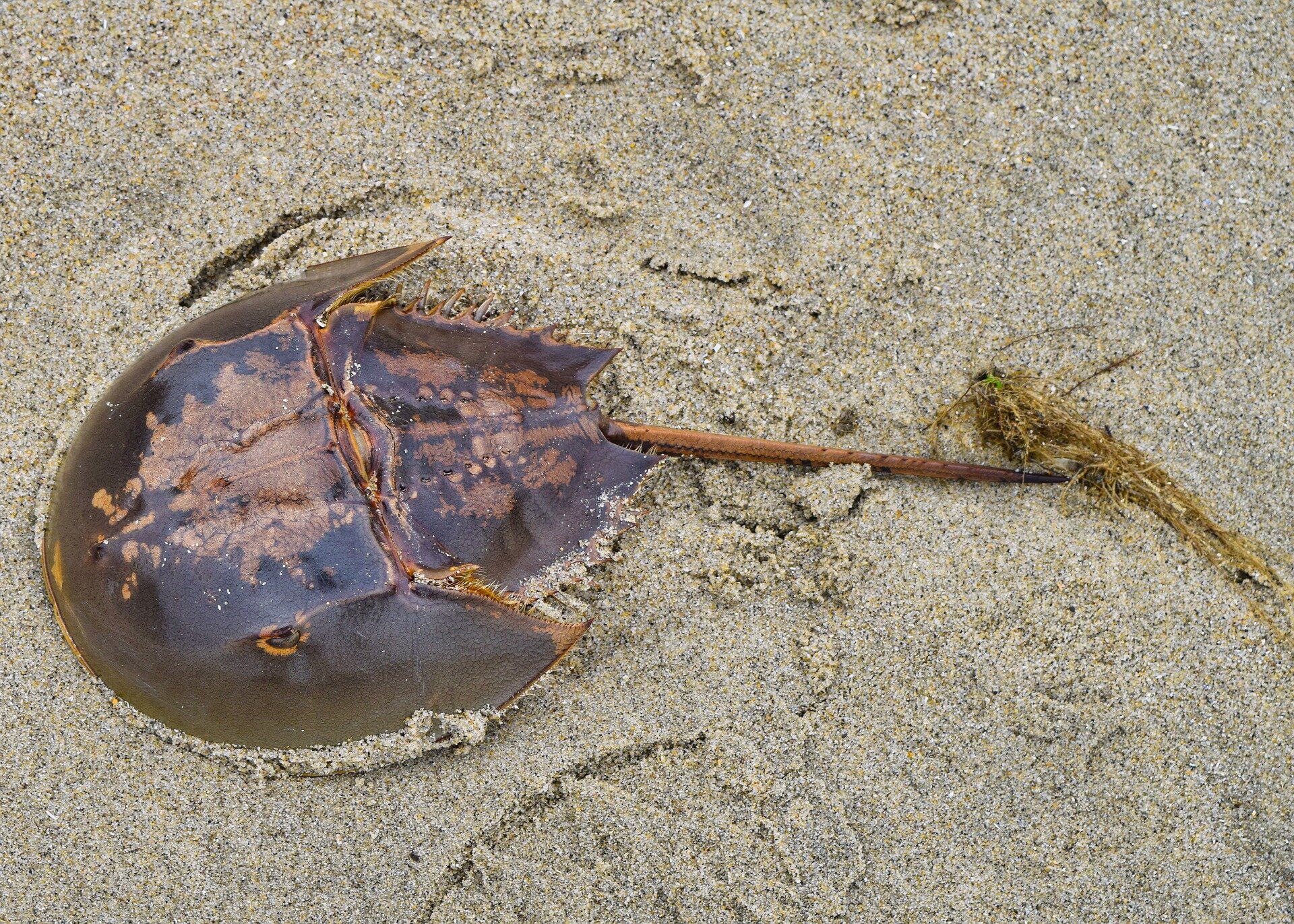A Living Fossil: Horseshoe Crabs & Vaccines
A Living Fossil: Horseshoe Crabs & Vaccines
Written by Kristine Manganelli (Somerset County 4-H Coordinator)
Horseshoe crab on beach
Horseshoe crabs must be doing something right—they have existed for over 400 million years—that’s 200 million years before the first dinosaurs roamed. Although planet earth has undergone some serious evolutionary changes in this time, horseshoe crabs have not. They are primarily the same critter that scurried along the shores long before the age of human kind.
Of the 4 horseshoe crab species, the Atlantic horseshoe crab is found up and down the east coast from Canada to Mexico, including here in New Jersey. In fact, the Delaware Bay which is our state’s southern border, is home to a majority of Atlantic horseshoe crabs, but they are also found in Raritan and Sandy Hook Bays. Each spring this area becomes the largest concentration of breeding horseshoe crabs in the world! The shallow depth of the Delaware Bay warms quickly after winter’s end. The warm temperatures prompt horseshoe crab spawning season.
This brings us to the present; on the new and full moons of May and June, horseshoe crabs undergo a local migration from the deep ocean waters and gather where the waves break on shore to mate and lay eggs. As this past Tuesday marked May’s new moon, the annual event has begun. Females will dig holes and lay anywhere from 3,000 to 10,000 eggs. Several males will hold onto her while fertilizing the eggs. Each female can lay up to 80,000 eggs by the end of spawning season.
The eggs will hatch in just 2 weeks and the tiny horseshoe crab will molt their outer shell or exoskeleton about once a year as it grows larger until reaching sexual maturity at 9-10 years of age when they will join the other adults on shore during spawning season. Horseshoe crabs can live up to 20 years in the wild.
Spawning horseshoe crabs
That is of course, if they survive their biggest threat…humans. Horseshoe crabs are not only used by fisherman as bait, they have very special blood. Milky-blue in color because of copper content, it contains the only known natural source of LAL (Limulus Amebocyte Lysate), a relic of their ancient immune systems. LAL causes their blood to clot in the presence of bacteria making it ultra-valuable to the pharmaceutical industry.
About half a million horseshoe crabs are harvested from the ocean each year so their blood can be used to test for contamination. The United States Food and Drug Administration requires that all IV drugs, vaccines, and medical devices such as pacemakers are tested using horseshoe crab blood. If any bacterial toxins end up in these products, the results can be deadly. This means that horseshoe crab blood has protected millions of human lives! The fact that the entire world relies on horseshoe crabs in this way is mind-boggling. The importance during a pandemic like COVID-19 and the surrounding vaccines cannot be stressed enough.
About 30% of a horseshoe crab’s blood is extracted and although they are returned to the ocean afterwards, the reality cannot be ignored that 10-30% will die at some point during this process. Despite the fact that horseshoe crabs are not considered an endangered species, its high demand has seriously declined population numbers, putting it on the list of “near threatened species.” As a result, it is illegal in New Jersey to remove one from its habitat for any reason, but the laws protecting horseshoe crabs vary state to state.
Since 1990 the Atlantic horseshoe crab population has dropped from 1.24 million crabs spawned in the Delaware Bay to 335,000 in 2019. Conservationists fear that the increased burden from the COVID vaccine will further imperil horseshoe crabs and the ecosystem that depends on them. At least 11 species of migrating shorebirds rely on horseshoe crab eggs as a primary food source. The availability of nutrient-rich eggs during migration is critical to the survival of these birds. The drop in horseshoe crab numbers also triggers a decline in any species that relies on them. Protecting horseshoe crabs helps the entire web it is a part of. While there are synthetic LAL alternatives, their safety and efficacy is still being studied.
Although they have made it 400 million years, horseshoe crabs need our help if they are to survive past the age of humans. Read on to learn how you can be of service.
Get Outside
If you ever find an upside down horseshoe crab while on the beach, it may be stranded! You can be a hero by flipping it over. Even though they may look scary, horseshoe crabs do not bite, and their claws are used for eating or walking, not pinching! The long tail or telson, is not used in defense, but rather to right themselves when flipped by a wave. Sometimes they get stuck, so the next time you come across an upside down horseshoe crab, lend a hand!
Volunteers with Save Coastal Wildlife have been monitoring horseshoe crab populations along the southern shore of the New York Harbor in Monmouth County, New Jersey since 2009 in an effort to see if the population is stable. Volunteers walk beaches to count the numbers of crabs present and tag crabs to track their movements. Volunteer sessions takes place on full moon and new moon evenings in May and June. No prior experience is necessary, but there is a required training.
For more information and to sign up as a volunteer for next year’s session, visit: savecoastalwildlife.org/horseshoe-crab-monitoring.
Sources:
Arnold, Carrie. “Horseshoe crab blood is key to making a COVID-19 vaccine—but the ecosystem may suffer.” National Geographic, July 2020, https://www.nationalgeographic.com/animals/article/covid-vaccine-needs-horseshoe-crab-blood. Accessed 13 May 2021.
Catania, Taran and Matt Danihel. “Horseshoe Crab.” New Jersey Endangered and Threatened Species Field Guide, 2013, Conserve Wildlife Foundation of New Jersey, http://www.conservewildlifenj.org/species/fieldguide/view/Limulus%20polyphemus/. Accessed 13 May 2021.
“It’s Not Easy Being a Horseshoe Crab Around New York Harbor!” Save Coastal Wildlife, https://www.savecoastalwildlife.org/save-horseshoe-crabs-in-new-york-harbor. Accessed 13 May 2021.

